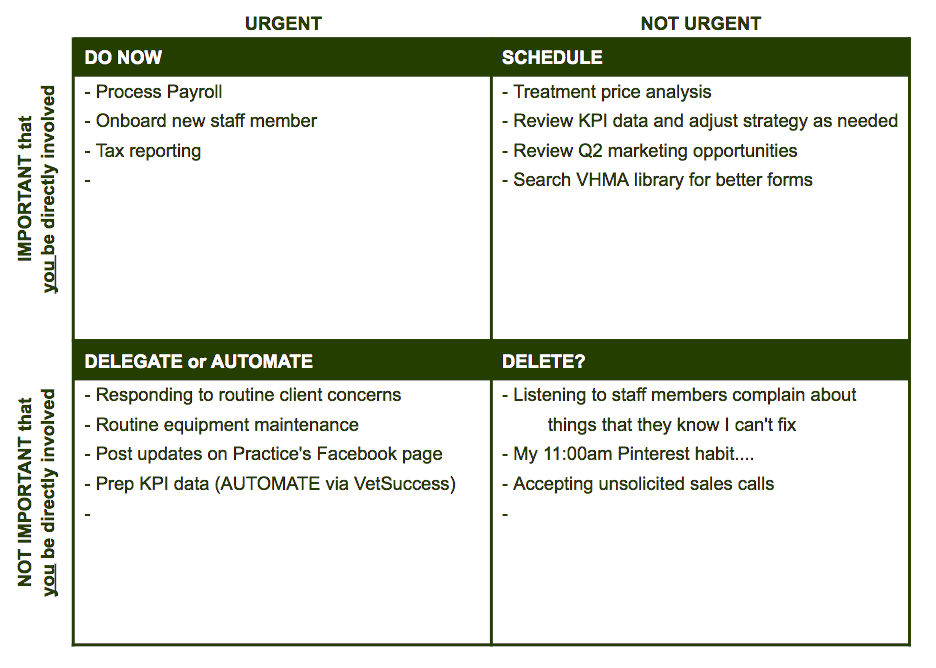Veterinary practice managers keep the wheels of the practice turning. From recruiting, staff training, and payroll administration to inventory control, budgeting, and everything in between, it’s an all-encompassing role.
While dedication and work ethic might make you feel you have to do it all, you can’t — or at least, you can’t without compromising your personal well-being and jeopardizing the future success of the practice. So is a practice manager to do? Start with these four steps to determine which tasks matter most and help manage responsibility overload.
Step 1: Recognize that the 80/20 rule probably applies to you
Also called the Pareto Principle, the 80/20 Rule speaks to the “law of the vital few.” Essentially, it states that 20% of our actions are responsible for 80% of our achievements. Flip this upside down, apply it to your job, and what it suggests is that 80% of your efforts only generate 20% of the overall value you bring to your practice.
As discouraging as this may sound, what it actually tells us is that we can generate greater value by selectively doing less. That’s good news! The question is: Which tasks and responsibilities should you let go of? That brings us to the next step.
Step 2: Conduct a task audit
For two weeks, keep a detailed list of every work-related task you undertake, whether it’s part of your job description or not, whether it’s during or outside business hours. Put everything on the list, whether you called Susan into your office for a chat when she showed up 20 minutes late, stopped at the bank during your lunch hour to drop off a deposit, or took a call from the practice owner in the evening to discuss an important staffing issue.
In addition, log any time wasted at work. Be honest; nobody has to see this list but you. Spent five minutes chatting with your mom? Snuck in 10 minutes to look for an easy weeknight dinner recipe? Caught up on Facebook for 15 minutes? It happens. Write it all down.
When the two weeks are up, organize the items on your list into categories — for example, inter-staff management, client relations, inventory control, and personal business. In all likelihood, there will be some monthly, quarterly, or annual tasks that didn’t come up during your two-week audit, such as generating financial and KPI reports or working on taxes. Think about the categories any unlogged tasks and responsibilities fall into and add those to your list. Once you’ve done this, you’re ready for step 3, which is where the magic starts to happen.
Step 3: Map out your responsibilities using the Eisenhower Matrix
 The Eisenhower Matrix, also known as the Urgent-Important Matrix, helps you prioritize tasks by sorting them into four quadrants ranging from critically important and urgent to utterly inconsequential.
The Eisenhower Matrix, also known as the Urgent-Important Matrix, helps you prioritize tasks by sorting them into four quadrants ranging from critically important and urgent to utterly inconsequential.
Using a matrix template, map out your responsibilities by putting them in the appropriate quadrants. Keep in mind that in this context, “important” is defined as any responsibility that’s important for you to handle, versus a responsibility that somebody else can handle or one that doesn’t need handling at all.
Quadrant 1, do now: Enter responsibilities that are both important and urgent. Processing payroll, for example, can’t be delayed and at many practices is a direct responsibility of the practice manager. The responsibilities entered here are your top priority. They must be completed in a timely manner and generally require your direct involvement.
Quadrant 2, schedule: Enter responsibilities that are important but not actually urgent. Yes, you need to update treatment prices, but the practice probably won’t fold if this doesn’t happen tomorrow or even next week. The responsibilities you enter here are next on your to-do list. Decide when these tasks need to be completed and set time aside accordingly.
 Quadrant 3, delegate or automate: The responsibilities entered here should be those that are urgent but not important. Remember, important means it’s not essential that you personally take care of it. Take preparing KPI reports, for example. Is it critical that you personally prepare, print, and distribute them? No. A member of your team should be capable of handling this. Or, better yet, automate KPI reporting with Vetsource’s Data & Insights solutions. If delegated, you’ll need to ensure the team member receives proper training and ideally has access to process documentation.
Quadrant 3, delegate or automate: The responsibilities entered here should be those that are urgent but not important. Remember, important means it’s not essential that you personally take care of it. Take preparing KPI reports, for example. Is it critical that you personally prepare, print, and distribute them? No. A member of your team should be capable of handling this. Or, better yet, automate KPI reporting with Vetsource’s Data & Insights solutions. If delegated, you’ll need to ensure the team member receives proper training and ideally has access to process documentation.
Quadrant 4, delete: What should remain on your category list are responsibilities that are neither important nor urgent, like listening to a team member gossip about a client or complaining for 20 minutes about something that’s clearly not a situation you’re able to address. Eliminating these items can be as simple as having an open conversation with your staff or advising team members to come prepared with a suggested resolution when bringing problems to your attention.
What about taking the occasional call from a family member or stealing a few moments to respond to a personal email while you’re at work? In reality, you’re not going to be 100% effective 100% of the time. Ultimately, the point of this exercise is to make sure you only end up performing tasks that you’re intentionally choosing to include in your day, and if checking in on Mom is one of them, that’s okay!
Step 4: Take action on Quadrants 1, 2, and 3
Do now what you need to do now, schedule time to manage the less urgent tasks that only you can do, delegate tasks and responsibilities that can be competently performed by other team members, and automate anything that can be accomplished using software or technology.
Once you’ve completed the four steps, you might still face some constraints due to the practice’s budget, ambiguity about your level of authority, or perhaps a less-than-understanding practice owner. But with your completed Urgent-Important Matrix in hand, you’ll be in a much stronger position to show how redistributing some of your responsibilities will ultimately benefit the practice.



